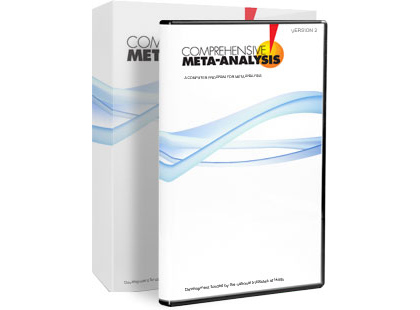



#COMPREHENSIVE META ANALYSIS EXCEL SOFTWARE#
We decided, a priori, to focus on software that was solely dedicated to meta-analysis of randomized therapeutic or observational causal studies. Therefore, the purpose of our study was to systematically compare features, results, and usability of the currently available meta-analysis software. We believe that information on the validity or comparability of results and ease-of-use are equally important factors in the total applicability of the software. Also, most of the existing reviews have focused on numerical features, such as which analytical models were available or what graphs could be produced. The most recent one, however, dates back to 5 years ago and in the meantime the spectrum of available software has changed substantially. To aid potential users in choosing the software that fits their needs, there are a number of reviews and comparisons available. This paper focuses on this area of causal medical research and in particular the software that is being used in the corresponding meta-analyses.Ĭomputer software has become indispensable in meta-analysis and in the last decennia many programs have been developed. Although meta-analysis is applied in many types of research, the bulk of published meta-analyses are in the domain of therapeutic and – albeit to a lesser extent – observational etiologic studies. As the quantitative part of a systematic review, the merit of meta-analysis over qualitative approaches lies in the formal and reproducible investigation of heterogeneity, small study effects, and other data trends. However, time has taught – both opponents and proponents – that things are not black and white meta-analysis, executed with care, has become an important and influential cornerstone of scientific medicine. The thick line represents the average effect according to the random-effects model.Meta-analysis has been characterized in various ways, from "making order of scientific chaos" to "mega-silliness", and has been subject of many debates. The resulting plot contains a \(p\)-value curve for each effect size, all in the shape of an upside down V. Let us try out the drapery function in an example using our m.gen meta-analysis object. Either "bottomright", "bottom", "bottomleft", "left", "topleft", "top", "topright", "right", or "center". Legend: Logical, indicating if a legend should be printed. Labels: When we set this argument to "studlab", the study labels will be included in the plot. If FALSE, only the summary effect is printed. Study.results: Logical, indicating if the results of each study should be included in the plot. This can be "zvalue" (default) for the test statistic, or the \(p\)-value ( "pvalue"). Type: Defines the type of value to be plotted on the y-axis. There are a few additional arguments, with the most important ones being: Overall, this allows others to quickly examine the precision and spread of the included studies, and how the pooled effect relates to the observed effect sizes. They also display the pooled effect we have calculated in a meta-analysis. Such plots provide a graphical display of the observed effect, confidence interval, and usually also the weight of each study. The most common way to visualize meta-analyses is through forest plots. We now come to a somewhat more pleasant part of meta-analyses, in which we visualize the results we obtained in previous steps.
#COMPREHENSIVE META ANALYSIS EXCEL HOW TO#
N the last chapters, we learned how we can pool effect sizes in R, and how to assess the heterogeneity in a meta-analysis.


 0 kommentar(er)
0 kommentar(er)
